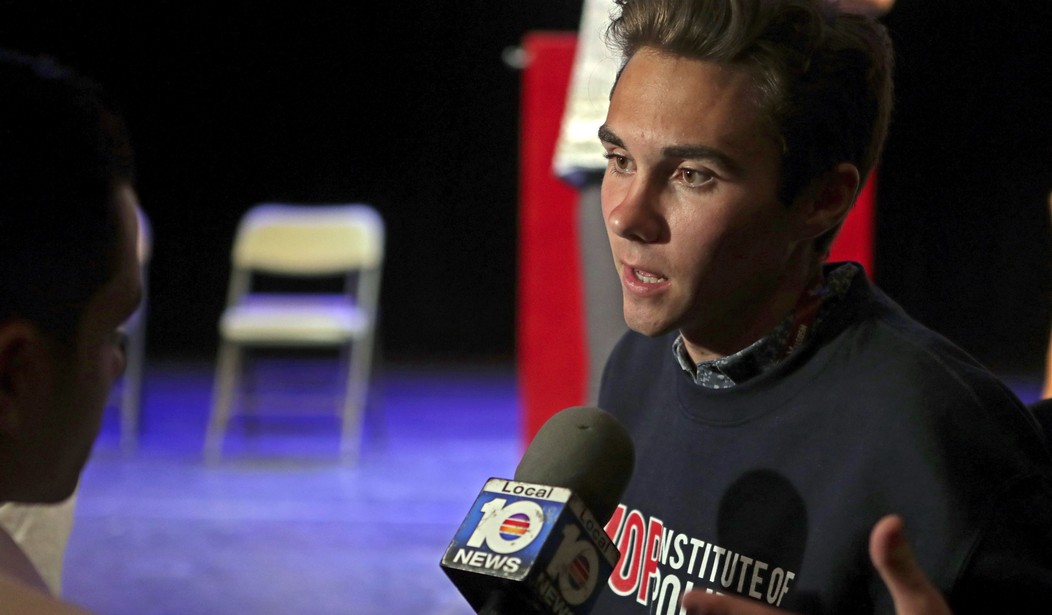You hear about the Trump country bubble and the liberal bubble, though the latter one is much, much denser. There may be one that could rival the dome encompassing Hillary’s America: the anti-gun bubble. You’d think after multiple tragedies and shoddy reporting concerning gun terminology, the media and their ilk would learn. They haven’t. It’s gotten worse. After the Marjory Stoneman Douglas High School shooting in February, the media still doesn’t know the difference between semi-automatic and automatic, one outlet thought a shotgun was an AR-15 rifle, and the media still doesn’t know that a) the AR-15 is a very popular rifle; b) you canhunt with it; c) it’s great for self-defense; and d) millions of Americans own them. They don’t know the laws either; the age to purchase rifles and shotguns has been 18 for years.
Recently, David Hogg, a Marjory Stoneman Douglas student and anti-gun activist, dropped his five-point plan for gun control.
It just reinforced what we already know about pro-gun control America: they don’t know the laws.
Hogg’s five-point platform is straightforward.
Comment why you do or don’t support our 5 point platform below I want to try responding to as many people as I can.
— David Hogg (@davidhogg111) May 11, 2018
1. CDC funding for research into gun violance
2. Universal Background checks
3. Digitization of ATF records
4. High-Capacity magazine ban
5. Assault weapons ban
He wants “CDC funding for research into gun violence [sic], universal, background checks, digitization of ATF records, high-capacity magazine ban, and assault weapons ban.”
Hogg, along with Cameron Kasky and Emma Gonzalez, also Marjory students, have become the new face of the effort to curb gun rights in America. All three are activists. All three could be linked to the spike in gun control activism, but also the rise in gun sales, National Rifle Association membership increases, and boosts in their fundraising. Yes, they scored a win when Florida Gov. Rick Scott signed an anti-gun bill into law after the tragic shooting. It banned bump stocks, provided more funding for mental health programs, the establishment of an anonymous tip line, and increased the age to purchase firearms to 21. The latter provision is unconstitutional and prompted the NRA to sue the state. They scored a win with an NRA-friendly, Republican governor. This wasn’t business as usual.
Recommended
Yet, the platform is riddled with inaccuracy. There is no ban on funding for gun violence studies by the CDC. In fact, the CDC backed a study in 2013 when Obama was president. Background checks are conducted for all sales through a federal firearms licensed dealer, where the vast majority of Americans purchase their firearms. Even FFL dealers who rent space for gun shows have to do a background check on all purchases.
The digitization of ATF records are something that can be debated, but on the periphery. It won’t stop mass shootings and the ATF isn’t supposed to keep permanent records in general, as we do not have a national registry. Also, these records used for tracing for gun crimes are eventually digitized. As for the so-called assault weapons ban, it won’t reduce gun crime, and that’s something that even liberal gun reporters have concluded. Even data crunchers at sites like FiveThirtyEight have admitted that UK-based gun reforms and what the anti-gun Left peddles won’t yield the results they’re craving—and it could lead to very bad public policy.
Via WaPo:
Before I started researching gun deaths, gun-control policy used to frustrate me. I wished the National Rifle Association would stop blocking common-sense gun-control reforms such as banning assault weapons, restricting silencers, shrinking magazine sizes and all the other measures that could make guns less deadly.
Then, my colleagues and I at FiveThirtyEight spent three months analyzing all 33,000 lives ended by guns each year in the United States, and I wound up frustrated in a whole new way. We looked at what interventions might have saved those people, and the case for the policies I’d lobbied for crumbled when I examined the evidence. The best ideas left standing were narrowly tailored interventions to protect subtypes of potential victims, not broad attempts to limit the lethality of guns.
I researched the strictly tightened gun laws in Britain and Australia and concluded that they didn’t prove much about what America’s policy should be. Neither nation experienced drops in mass shootings or other gun related-crime that could be attributed to their buybacks and bans. Mass shootings were too rare in Australia for their absence after the buyback program to be clear evidence of progress. And in both Australia and Britain, the gun restrictions had an ambiguous effect on other gun-related crimes or deaths.
So, the anti-gun Left has just rehashed what they mostly have clamored for in years past. The only difference is that they’re using high school kids to do it. None of this will pass now, but that could all change if Democrats have a good midterm election year. So, don’t forget to vote, folks.



















Join the conversation as a VIP Member